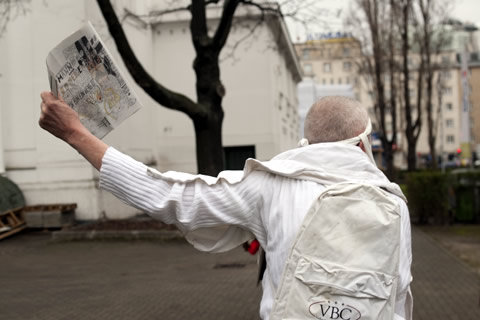Pawel Althamer and the others
dal 23/4/2009 al 20/6/2009
Segnalato da
23/4/2009
Pawel Althamer and the others
Wiener Secession, Wien
For this exhibition, that makes use of the entire building and the garden, the artist creates a tunnel-like corridor, accessible around the clock, that runs through the building straight into the garden beyond, where he initiates a public site for communication with simple means. An evening camp fire - for Althamer a symbol and archetype of the "round table" - acts as the centre of informal gatherings. Although ahead of the exhibition the artist has specifically prompted various people for example Donat Grzechowiak, students of the Academy of Fine Arts / Performance Art class, Sudtirolerplatz-Gunther and friends and residents of the Neu Albern refugee house to take part.

For his exhibition at the Secession, that makes use of the entire building and the garden, the Polish artist Pawel Althamer creates a tunnel-like corridor, accessible around the clock, that runs through the building straight into the garden beyond, where he initiates a public site for communication with simple means. An evening camp fire – for Althamer a symbol and archetype of the “round table” – acts as the centre of informal gatherings and meetings. Although ahead of the exhibition the artist has specifically prompted various people for example Donat Grzechowiak, students of the Academy of Fine Arts / Performance Art class, Südtirolerplatz-Günther and friends and residents of the Neu Albern refugee house to take part, basically everyone is invited to make use of the temporary outdoor space.
A characteristic feature of Pawel Althamer’s poetic interventions, enactments and sculptures is that they are based upon the meticulous observation and analysis of everyday situations and social conventions. Many times he has invited others to take part in his projects or asked them to assume different roles so as to explore everyday life and the socio-economic conditions of certain groups. As a re-assessment of “invisible theatre”he often sees the public space in this context as a stage, focusing on the seemingly unspectacular in order to emphasise or shift the experience of a certain reality by means of minimal manipulations of existing structures.
Althamer’s intervention at the Secession also transforms the traditional use and perception of the institution: Instead of approaching the art via the entrance hall, set back from the everyday bustle of the street, visitors are guided right through the building. The exhibition space is rather masked out, and the place that invites visitors to stay a while is removed into a natural setting, an open situation that cannot be controlled. Continuous change, unpredictability and loss of control are inherent factors in Pawel Althamer’s works. This also involves giving up and transferring authorship to others. This is based on an artistic understanding of himself and his work that does not regard art and life as separate.
Pawel Althamer (b. in Warsaw in 1967) lives and works in Warsaw.
Catalogue
On 3 June 2009 a special issue of the Viennese street journal “Augustin” (www.augustin.or.at) will be published, a co-production of the Secession and the “Augustin” editors that focuses on this project. Hence, the project documentation is based on the same idea as the project itself: control over what voices are allowed to speak is relinquished or left open.
Solo shows (selection)
2009 Secession, Vienna; Frühling, Kunsthalle Fridericianum, Kassel; 2007 One of Many, Fondazione Nicola Trussardi, Milan; Black Market, Galerie neugerriemschneider, Berlin; 2006 Pawel Althamer, Centre Pompidou - Musée National d´Art Moderne, Paris; 2005 Pawel Althamer, Zachęta Narodowa Galeria Sztuki, Warsaw; 2004 The Vincent Award, Bonnefantenmuseum, Maastricht; Spacer z Fundacją Galerii Foksal po Pradze, Foksal Gallery Foundation, Warsaw.
Group shows (selection)
2008 After Nature, New Museum of Contemporary Art, New York; Double Agent, ICA, London; Mimétisme, Extra City centrum voor hedendaagse kunst, Antwerp; 2007 1,2,3…VANGUARDIAS. El arte como arte contextual, Sala Rekalde, Bilbao; The World as a Stage, Tate Modern, London; Volksgarten. Politics of Belonging, Kunsthaus Graz; Skulptur Projekte Münster 07, Münster; Quantity as Quality, Kunsthalle Exnergasse, Vienna; 2006 Of Mice and Men, 4. Berlin Biennale for contemporary art, Berlin; Kontakt. Aus der Sammlung der Erste Bank-Gruppe, Museum Moderner Kunst Stiftung Ludwig Wien, Vienna; 2005 9. Istanbul Biennial, Istanbul; Positioning. In the New Reality of Europe, The National Museum of Art Osaka; Das unmögliche Theater, Kunsthalle Wien, Vienna; 2004 Utopia Station, Haus der Kunst, Munich; Stanisław Ignacy Witkiewicz. Philosophical Margins, CCA, Warsaw; Under the white-red flag. New Art from Poland, Estorian Art Museum, Exhibition Hall in the Rotermann Salt Storage, Tallinn; 2003 Dreams and Conflicts – The Viewer’s Dictatorship, 50. Biennale Venice; 2002 I promise it’s political, Museum Ludwig, Cologne; 2001 Ausgeträumt…, Secession, Vienna.
Photo: Lukas Beck
The exhibitions are realized through support of:
Erste Bank – Partner of the Secession
Wien Kultur
Bundesministerium für Unterricht, Kunst und Kultur
Friends of the Secession
Cooperation partners:
Augustin, Polnisches Kulturinstitut, das möbel
Media partners:
Der Standard, Ö1 Club, Silver Server
Non-cash benefit:
Aida Café - Konditorei, Bäckerei Gül, Le Méridien,
Securitas Sicherheitsdienstleistungen GmbH, Ströck Brot, Trumer Privatbrauerei
For further information and photographic material please contact:
Kathrin Schweizer
Friedrichstraße 12, 1010 Vienna Tel: +43-1-5875307-21, Fax: +43-1-5875307-34 presse@secession.at
Press conference Friday, April 24, 2009, 10 a.m.
Opening Friday, April 24, 2009, 7 p.m.
Wiener Secession
Friedrichstrasse 12 - Wien



